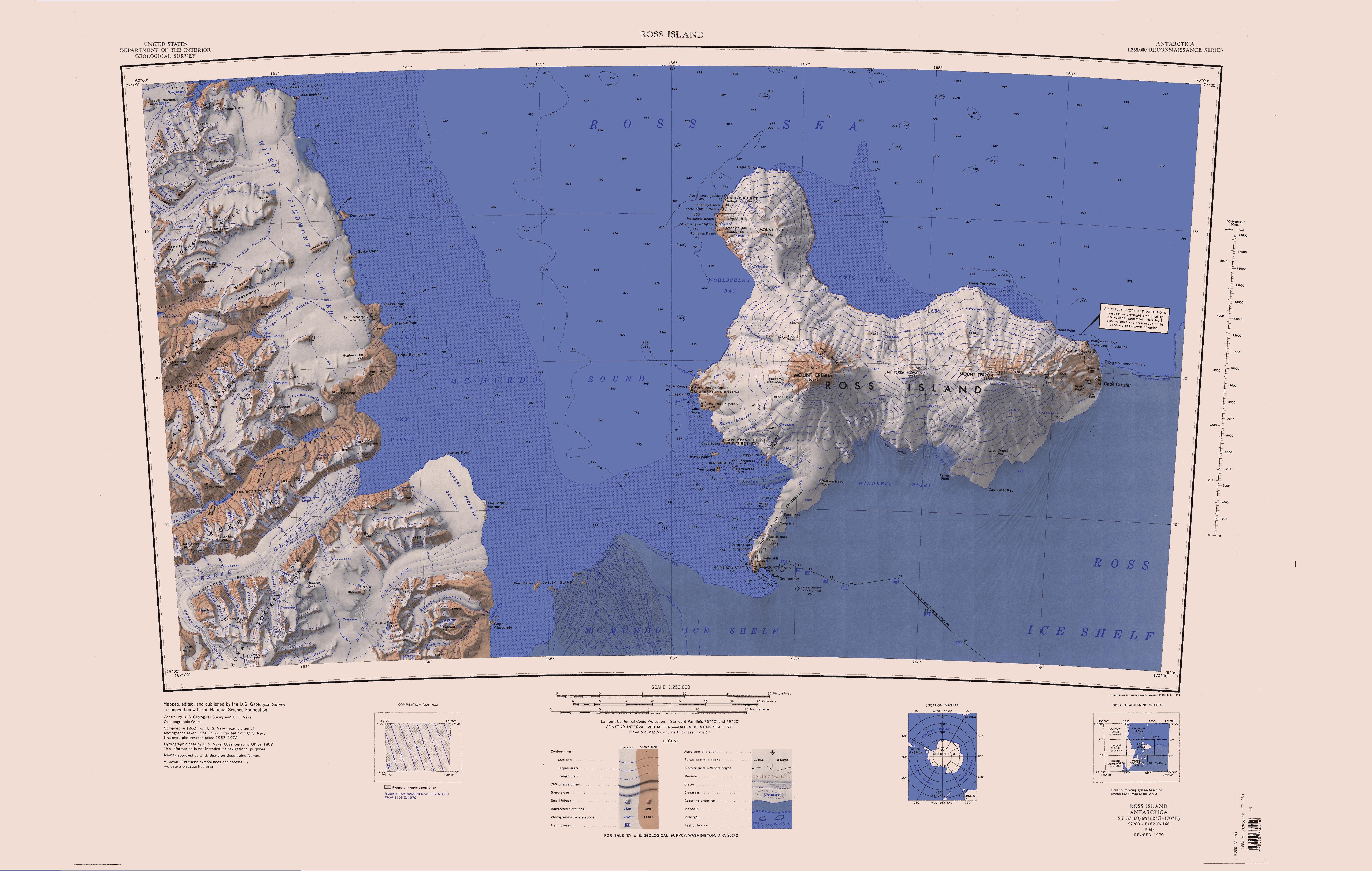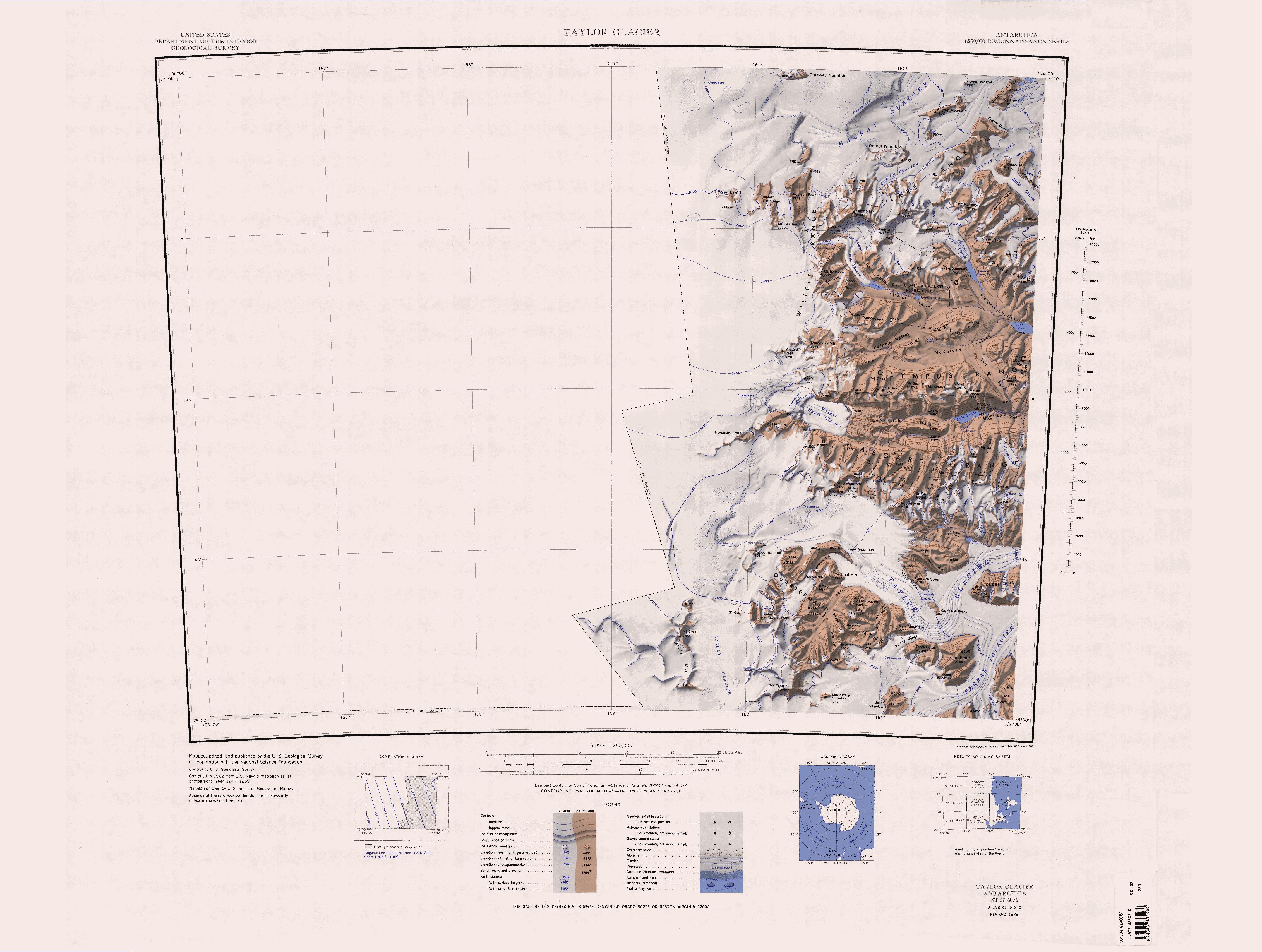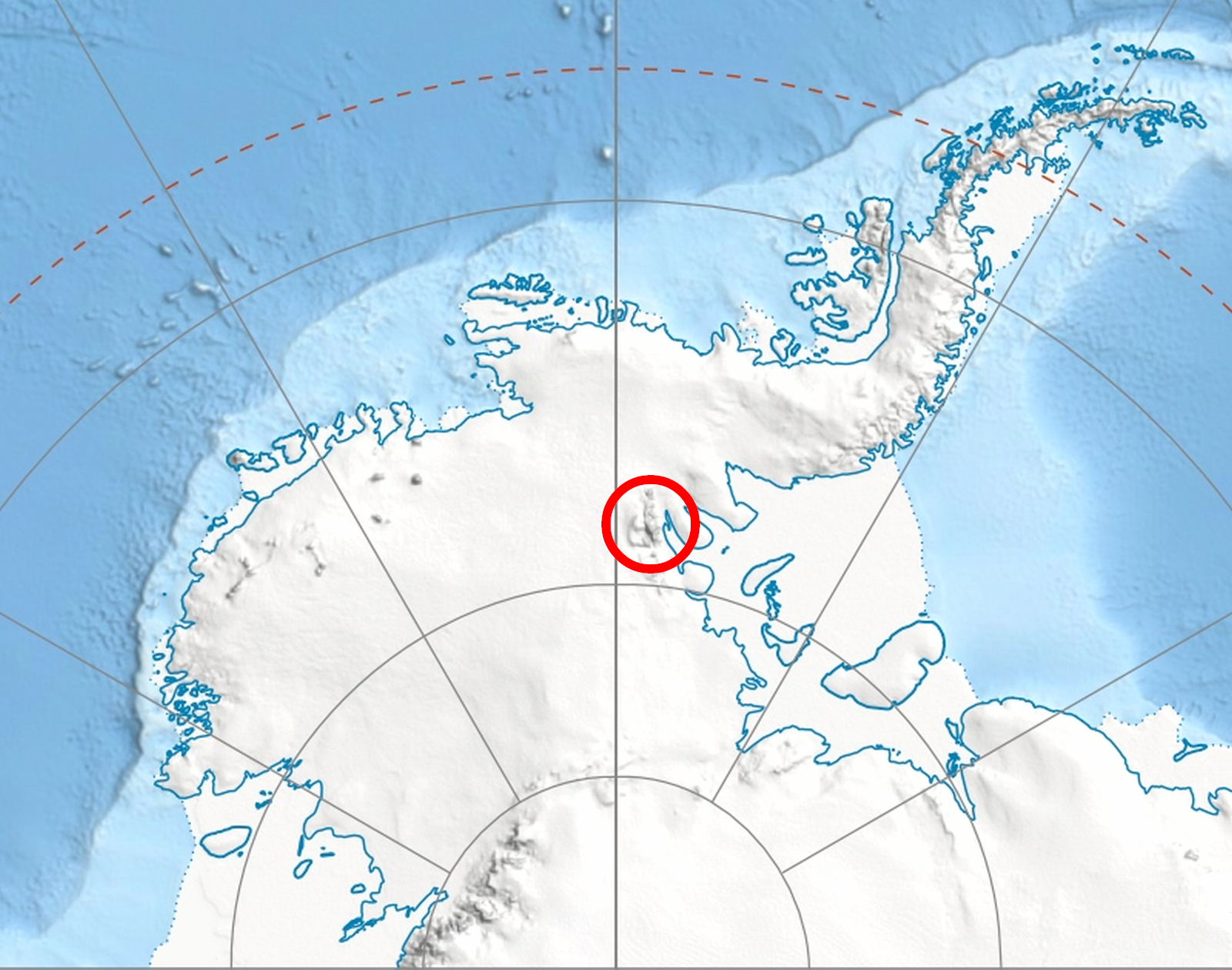|
Mount Coleman (Antarctica)
The MacDonald Hills () are a compact group of exposed rock hills in the Asgard Range, east of Commonwealth Glacier on the north side of lower Taylor Valley, Victoria Land, Antarctica. The hills were named by the Advisory Committee on Antarctic Names (US-ACAN) (1997) after William R. MacDonald (1925–77), Chief of the Branch of International Activities, U.S. Geological Survey, and a member of the US-ACAN, part of the U.S. Board on Geographic Names, 1976–77 (see MacDonald Peak). Named features Features include: Mount Coleman . A rounded mountain, high, standing immediately east of Commonwealth Glacier at the head of New Harbor in Victoria Land. Mapped by the BrAE under Scott, 1910-13. Named by C.S. Wright, a member of the expedition, for Professor Coleman, geologist, of Toronto University, Canada. Harp Hill . A detached hill high that is triangular in plan, the northwest and southeast sides of which are defined by ridgelike rock exposures, located at the north side ... [...More Info...] [...Related Items...] OR: [Wikipedia] [Google] [Baidu] |
Antarctica
Antarctica () is Earth's southernmost and least-populated continent. Situated almost entirely south of the Antarctic Circle and surrounded by the Southern Ocean (also known as the Antarctic Ocean), it contains the geographic South Pole. Antarctica is the fifth-largest continent, being about 40% larger than Europe, and has an area of . Most of Antarctica is covered by the Antarctic ice sheet, with an average thickness of . Antarctica is, on average, the coldest, driest, and windiest of the continents, and it has the highest average elevation. It is mainly a polar desert, with annual Climate of Antarctica#Precipitation, precipitation of over along the coast and far less inland. About 70% of the world's freshwater reserves are frozen in Antarctica, which, if melted, would raise global sea levels by almost . Antarctica holds the record for the Lowest temperature recorded on Earth, lowest measured temperature on Earth, . The coastal regions can reach temperatures over in the ... [...More Info...] [...Related Items...] OR: [Wikipedia] [Google] [Baidu] |
Victoria Land
Victoria Land is a region in eastern Antarctica which fronts the western side of the Ross Sea and the Ross Ice Shelf, extending southward from about 70°30'S to 78th parallel south, 78°00'S, and westward from the Ross Sea to the edge of the Antarctic Plateau. It was discovered by Captain James Clark Ross in January 1841 and named after Victoria of the United Kingdom, Queen Victoria. The rocky promontory of Minna Bluff is often regarded as the southernmost point of Victoria Land, and separates the Scott Coast to the north from the Hillary Coast of the Ross Dependency to the south. History Early explorers of Victoria Land include James Clark Ross and Douglas Mawson. In 1979, scientists discovered a group of 309 Meteorite, meteorites in Antarctica, some of which were found near the Allan Hills in Victoria Land. The meteorites appeared to have undergone little change since they were formed at what scientists believe was the birth of the Solar System. In 1981, Lichen, lichens fo ... [...More Info...] [...Related Items...] OR: [Wikipedia] [Google] [Baidu] |
Asgard Range
The Asgard Range () is a mountain range in Victoria Land, Antarctica. It divides Wright Valley from Taylor Glacier and Taylor Valley. It is south of the Olympus Range and north of the Quartermain Mountains and the Kukri Hills. Name The Asgard Range was named by the Victoria University of Wellington Antarctic Expedition (1958–59) after Asgard, the home of the Norse gods. Location The Asgard Range extends in a west–east direction from Wright Upper Glacier, below the Antarctic Plateau, to Mount Newall above the Wilson Piedmont Glacier, which extends along the west coast of the Ross Sea. To the north, the Asgard Range is separated from the Olympus Range by the Wright Upper Glacier and the Wright Valley, from which the Wright Lower Glacier flows into the Wilson Piedmont Glacier. To the south, the Taylor Glacier and Taylor Valley separate the Asgard Range from the Quartermain Mountains and the Kukri Hills. Surrounding major glaciers and valleys * Wright Upper Glacie ... [...More Info...] [...Related Items...] OR: [Wikipedia] [Google] [Baidu] |
Commonwealth Glacier
Taylor Valley is an ice-free valley about long, once occupied by the receding Taylor Glacier. It lies north of the Kukri Hills between the Taylor Glacier and New Harbour (Antarctica), New Harbour in Victoria Land, Antarctica. Taylor Valley is the southernmost of the three large McMurdo Dry Valleys in the Transantarctic Mountains, located west of McMurdo Sound. Exploration and naming The Taylor Valley was discovered by the British National Antarctic Expedition (BrNAE, 1901–04). It was more fully explored by the British Antarctic Expedition, 1907–09 (BrAE) and the British Antarctic Expedition, 1910–13. It was named after the Taylor Glacier. Geology In the oblique aerial photo at right, the tan bands are sandstone layers from the Beacon Supergroup, a series of sedimentary rock layers formed at the bottom of a shallow sea between 250 million and 400 million years ago. Throughout that period, Earth's southern continents were locked into the supercontinent Gondwana. The dark ... [...More Info...] [...Related Items...] OR: [Wikipedia] [Google] [Baidu] |
Taylor Valley
Taylor Valley is an ice-free valley about long, once occupied by the receding Taylor Glacier. It lies north of the Kukri Hills between the Taylor Glacier and New Harbour in Victoria Land, Antarctica. Taylor Valley is the southernmost of the three large McMurdo Dry Valleys in the Transantarctic Mountains, located west of McMurdo Sound. Exploration and naming The Taylor Valley was discovered by the British National Antarctic Expedition (BrNAE, 1901–04). It was more fully explored by the British Antarctic Expedition, 1907–09 (BrAE) and the British Antarctic Expedition, 1910–13. It was named after the Taylor Glacier. Geology In the oblique aerial photo at right, the tan bands are sandstone layers from the Beacon Supergroup, a series of sedimentary rock layers formed at the bottom of a shallow sea between 250 million and 400 million years ago. Throughout that period, Earth's southern continents were locked into the supercontinent Gondwana. The dark band of rock th ... [...More Info...] [...Related Items...] OR: [Wikipedia] [Google] [Baidu] |
Advisory Committee On Antarctic Names
The Advisory Committee on Antarctic Names (ACAN or US-ACAN) is an advisory committee of the United States Board on Geographic Names responsible for recommending commemorative names for features in Antarctica. History The committee was established in 1943 as the Special Committee on Antarctic Names (SCAN). It became the Advisory Committee on Antarctic Names in 1947. Fred G. Alberts was Secretary of the Committee from 1949 to 1980. By 1959, a structured nomenclature was reached, allowing for further exploration, structured mapping of the region and a unique naming system. A 1990 ACAN gazeeter of Antarctica listed 16,000 names. Description The United States does not recognise territorial boundaries within Antarctica, so ACAN assigns names to features anywhere within the continent, in consultation with other national nomenclature bodies where appropriate, as defined by the Antarctic Treaty System. The research and staff support for the ACAN is provided by the United States Geologi ... [...More Info...] [...Related Items...] OR: [Wikipedia] [Google] [Baidu] |
William R
William is a masculine given name of Germanic origin. It became popular in England after the Norman conquest in 1066,All Things William"Meaning & Origin of the Name"/ref> and remained so throughout the Middle Ages and into the modern era. It is sometimes abbreviated "Wm." Shortened familiar versions in English include Will or Wil, Wills, Willy, Willie, Bill, Billie, and Billy. A common Irish form is Liam. Scottish diminutives include Wull, Willie or Wullie (as in Oor Wullie). Female forms include Willa, Willemina, Wilma and Wilhelmina. Etymology William is related to the German given name ''Wilhelm''. Both ultimately descend from Proto-Germanic ''*Wiljahelmaz'', with a direct cognate also in the Old Norse name ''Vilhjalmr'' and a West Germanic borrowing into Medieval Latin ''Willelmus''. The Proto-Germanic name is a compound of *''wiljô'' "will, wish, desire" and *''helmaz'' "helm, helmet".Hanks, Hardcastle and Hodges, ''Oxford Dictionary of First Names'', Oxfor ... [...More Info...] [...Related Items...] OR: [Wikipedia] [Google] [Baidu] |
MacDonald Peak
MacDonald Peak is a peak rising to midway between Shockey Peak and Mount Crawford near the north end of the main ridge of the Sentinel Range, Antarctica. It was discovered by Lincoln Ellsworth on his trans-Antarctic flight of November 23, 1935, and was named by the Advisory Committee on Antarctic Names (US-ACAN) in 1961 for William R. MacDonald of the Branch of Special Maps in the United States Geological Survey (USGS) who prepared the 1962 map of this range. Subsequently, MacDonald participated in numerous expeditions to Antarctica to supervise aerial photography used in preparing USGS maps of the continent. At the time of his death in 1977 he was Chief of the Branch of International Activities in the USGS and a member of the US-ACAN, part of the U.S. Board on Geographic Names. See also * Mountains in Antarctica This is a list of all the ultra prominent peaks (with topographic prominence greater than 1,500 metres) in Antarctica. Some islands in the South Atlantic have als ... [...More Info...] [...Related Items...] OR: [Wikipedia] [Google] [Baidu] |
Hills Of Victoria Land
A hill is a landform that extends above the surrounding terrain. It often has a distinct summit, and is usually applied to peaks which are above elevation compared to the relative landmass, though not as prominent as mountains. Hills fall under the category of slope landforms. Terminology The distinction between a hill and a mountain is unclear and largely subjective, but a hill is universally considered to be not as tall, or as steep as a mountain. Geographers historically regarded mountains as hills greater than above sea level. In contrast, hillwalkers have tended to regard mountains as peaks above sea level. The ''Oxford English Dictionary'' also suggests a limit of and Whittow states "Some authorities regard eminences above as mountains, those below being referred to as hills." Today, a mountain is usually defined in the UK and Ireland as any summit at least high, while the UK government's Countryside and Rights of Way Act 2000 defined mountainous areas (for the ... [...More Info...] [...Related Items...] OR: [Wikipedia] [Google] [Baidu] |





